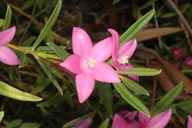Information about plants in flower this week
A news sheet prepared by a Gardens' volunteer, featuring the flowers, fruits and foliage of a selection of plants in
the Australian National Botanic Gardens .
Numbers before each plant refer to temporary IFTW labels in the gardens.
Numbers in square brackets [ ] refer to garden bed Sections. Featured plants are in bold type.
View past issues of 'In Flower This Week'.
20 July - 2 August 2016
Today we will walk around the environs of the café then up the hill towards the Rock Garden.
- Turn left as you leave the café to see on your left Correa baeuerlenii [Section 131] with long green bell flowers and shiny foliage. The calyx has an expanded base which looks like a chef's hat, resulting in the shrub's common name, Chef's Cap Correa. It is endemic to southern coastal New South Wales.
- Also on your left is Banksia ‘Stumpy Gold’ [Section 131] with fine, toothed linear foliage and masses of short gold cones with rusty red styles. This plant is a dwarf cultivar of Banksia spinulosa var. collina that was selected by Richard Anderson of Merricks Nursery in Victoria from material collected on the New South Wales Central Coast.
- Bear right down the path to see on your right in a pot Dracophyllum macranthum [Section 240], with upright stems of pointed green foliage and dark pink tubular flowers with white tips. This plant is known only from the Lansdowne State Forest in New South Wales and is listed as vulnerable.
- On your left is Crowea exalata ‘Southern Stars’ [Section 240], a dainty bush with dark green foliage and pink star flowers.
- Still on your left is Crowea saligna ‘Rosy Glow’ [Section 240], a small neat bush of green foliage with large pink star flowers.
- To the rear on your left is Crowea ‘Cooper’s Hybrid’ [Section 240], a lax bush with dark green foliage and darker pink star flowers.Crowea 'Cooper's Hybrid' is a cross between C. exalata and C. saligna. It arose as a seedling in the garden of Mrs. R. Cooper of Turramurra, New South Wales, in 1983.
- Pomaderris obcordata [Section 240] is also on your left, a small bush with tiny green leaves and small clusters of pink flowers. It is found in the wild mainly along the south coast of South Australia.
- On your right is Corymbia ficifolia ‘Dwarf Orange’ [Section 240], a small tree with green foliage, pink stems and magnificent nuts. This grafted gum, derived from a Western Australian species, is one of the most spectacular when in full flower.
- Behind the Corymbia, also on your right, is Grevillea rosmarinifolia ‘Scarlet Sprite’ [Section 240], just coming into bloom with bright red clusters of flowers on a neat bush of fine green foliage.
- Turn left up the hill, then up the steps to see on your left Acacia alata var. biglandulosa [Section 240], or Winged Wattle, with flattened phyllodes and masses of white fluffy balls of flowers. It is native to Western Australia.
- Continue up the hill to see Banksia spinulosa var. collina [Section 27] on your left, with fine linear foliage and slender, dull gold cones. This shrub, commonly known as Hill Banksia or Golden Candlesticks, grows along the east coast of Australia in Queensland and New South Wales.
- Further on your left is Banksia spinulosa var. spinulosa [Section 109], or Hairpin Banksia, which is found in open forests and woodlands of the coasts and mountains of New South Wales and Queensland.
- Further up the hill on your left is Grevillea aspleniifolia [Section 124], a very large sprawling shrub with long linear toothed green foliage and pink “toothbrush” flowers. It is endemic to New South Wales.
- Also on your left is Correa alba [Section 124], with grey-green leaves and white star flowers. This correa is a popular and reliable plant in the garden. It is native to eastern coastal regions of Australia from northern New South Wales to Tasmania and into eastern South Australia.
- On your right is Geijera parviflora [Section 4], or Wilga, a small tree with attractive linear green leaves which are aromatic when crushed. This tree occurs primarily in dry inland New South Wales, but is also scattered in Queensland, Victoria, South Australia and Western Australia.
Rosalind Walcott
![Director of National Parks [logo]](../../../../images/dnp_90px.gif)







